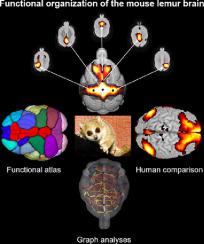当前位置:
X-MOL 学术
›
NeuroImage
›
论文详情
Our official English website, www.x-mol.net, welcomes your
feedback! (Note: you will need to create a separate account there.)
Resting state functional atlas and cerebral networks in mouse lemur primates at 11.7 Tesla
NeuroImage ( IF 4.7 ) Pub Date : 2021-02-01 , DOI: 10.1016/j.neuroimage.2020.117589 Clément M. Garin , Nachiket A. Nadkarni , Brigitte Landeau , Gaël Chételat , Jean-Luc Picq , Salma Bougacha , Marc Dhenain
NeuroImage ( IF 4.7 ) Pub Date : 2021-02-01 , DOI: 10.1016/j.neuroimage.2020.117589 Clément M. Garin , Nachiket A. Nadkarni , Brigitte Landeau , Gaël Chételat , Jean-Luc Picq , Salma Bougacha , Marc Dhenain

|
Measures of resting-state functional connectivity allow the description of neuronal networks in humans and provide a window on brain function in normal and pathological conditions. Characterizing neuronal networks in animals is complementary to studies in humans to understand how evolution has modelled network architecture. The mouse lemur (Microcebus murinus) is one of the smallest and more phylogenetically distant primates as compared to humans. Characterizing the functional organization of its brain is critical for scientists studying this primate as well as to add a link for comparative animal studies. Here, we created the first functional atlas of mouse lemur brain and describe for the first time its cerebral networks. They were classified as two primary cortical networks (somato-motor and visual), two high-level cortical networks (fronto-parietal and fronto-temporal) and two limbic networks (sensory-limbic and evaluative-limbic). Comparison of mouse lemur and human networks revealed similarities between mouse lemur high-level cortical networks and human networks as the dorsal attentional (DAN), executive control (ECN), and default-mode networks (DMN). These networks were however not homologous, possibly reflecting differential organization of high-level networks. Finally, cerebral hubs were evaluated. They were grouped along an antero-posterior axis in lemurs while they were split into parietal and frontal clusters in humans.
中文翻译:

小鼠狐猴灵长类动物在 11.7 特斯拉的静息状态功能图谱和大脑网络
静息状态功能连接的测量允许描述人类神经元网络,并提供正常和病理条件下大脑功能的窗口。表征动物的神经元网络是对人类研究的补充,以了解进化如何建模网络架构。与人类相比,小鼠狐猴 (Microcebus murinus) 是体型最小、系统发育更远的灵长类动物之一。表征其大脑的功能组织对于研究这种灵长类动物的科学家以及为比较动物研究添加链接至关重要。在这里,我们创建了第一个小鼠狐猴大脑的功能图谱,并首次描述了它的大脑网络。它们被归类为两个主要的皮质网络(躯体运动和视觉),两个高级皮质网络(额顶叶和额颞叶)和两个边缘网络(感觉边缘和评价边缘)。小鼠狐猴和人类网络的比较揭示了小鼠狐猴高级皮层网络与人类网络之间的相似性,如背侧注意 (DAN)、执行控制 (ECN) 和默认模式网络 (DMN)。然而,这些网络不是同源的,可能反映了高级网络的不同组织。最后,评估大脑中枢。它们在狐猴中沿前后轴分组,而在人类中则分为顶叶和额叶簇。小鼠狐猴和人类网络的比较揭示了小鼠狐猴高级皮层网络与人类网络之间的相似性,如背侧注意 (DAN)、执行控制 (ECN) 和默认模式网络 (DMN)。然而,这些网络不是同源的,可能反映了高级网络的不同组织。最后,评估大脑中枢。它们在狐猴中沿前后轴分组,而在人类中则分为顶叶和额叶簇。小鼠狐猴和人类网络的比较揭示了小鼠狐猴高级皮层网络与人类网络之间的相似性,如背侧注意 (DAN)、执行控制 (ECN) 和默认模式网络 (DMN)。然而,这些网络不是同源的,可能反映了高级网络的不同组织。最后,评估大脑中枢。它们在狐猴中沿着前后轴分组,而在人类中它们被分成顶叶和额叶簇。
更新日期:2021-02-01
中文翻译:

小鼠狐猴灵长类动物在 11.7 特斯拉的静息状态功能图谱和大脑网络
静息状态功能连接的测量允许描述人类神经元网络,并提供正常和病理条件下大脑功能的窗口。表征动物的神经元网络是对人类研究的补充,以了解进化如何建模网络架构。与人类相比,小鼠狐猴 (Microcebus murinus) 是体型最小、系统发育更远的灵长类动物之一。表征其大脑的功能组织对于研究这种灵长类动物的科学家以及为比较动物研究添加链接至关重要。在这里,我们创建了第一个小鼠狐猴大脑的功能图谱,并首次描述了它的大脑网络。它们被归类为两个主要的皮质网络(躯体运动和视觉),两个高级皮质网络(额顶叶和额颞叶)和两个边缘网络(感觉边缘和评价边缘)。小鼠狐猴和人类网络的比较揭示了小鼠狐猴高级皮层网络与人类网络之间的相似性,如背侧注意 (DAN)、执行控制 (ECN) 和默认模式网络 (DMN)。然而,这些网络不是同源的,可能反映了高级网络的不同组织。最后,评估大脑中枢。它们在狐猴中沿前后轴分组,而在人类中则分为顶叶和额叶簇。小鼠狐猴和人类网络的比较揭示了小鼠狐猴高级皮层网络与人类网络之间的相似性,如背侧注意 (DAN)、执行控制 (ECN) 和默认模式网络 (DMN)。然而,这些网络不是同源的,可能反映了高级网络的不同组织。最后,评估大脑中枢。它们在狐猴中沿前后轴分组,而在人类中则分为顶叶和额叶簇。小鼠狐猴和人类网络的比较揭示了小鼠狐猴高级皮层网络与人类网络之间的相似性,如背侧注意 (DAN)、执行控制 (ECN) 和默认模式网络 (DMN)。然而,这些网络不是同源的,可能反映了高级网络的不同组织。最后,评估大脑中枢。它们在狐猴中沿着前后轴分组,而在人类中它们被分成顶叶和额叶簇。











































 京公网安备 11010802027423号
京公网安备 11010802027423号